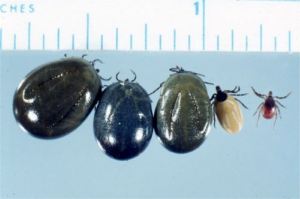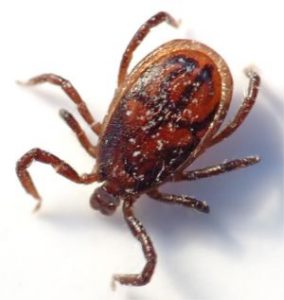What is a tick and where does it live?
 Ticks are parasites that need to consume blood from a host animal to survive. They split their time between grassy environments and feeding on host animals (such as dogs, birds and humans). The adult, nymphal and larval stages of ticks find their hosts by detecting exhaled carbon dioxide, vibrations and shadows. After climbing on the host the tick embeds its sharp mouth-parts into the skin and feeds on blood for hours to days. After feeding, the tick drops off the host and develops through its lifecycle.
Ticks are parasites that need to consume blood from a host animal to survive. They split their time between grassy environments and feeding on host animals (such as dogs, birds and humans). The adult, nymphal and larval stages of ticks find their hosts by detecting exhaled carbon dioxide, vibrations and shadows. After climbing on the host the tick embeds its sharp mouth-parts into the skin and feeds on blood for hours to days. After feeding, the tick drops off the host and develops through its lifecycle.
Why can ticks cause a problem?
When feeding the tick releases saliva into the host which acts as a method of disease and bacterial transfer. The three most important problems caused by ticks are described below:
 Local bacterial infections: – bacteria can enter the tick bite wound and cause a local infection. This causes the area where the tick has bitten to become a red and inflamed lump which may ooze pus. If you notice this on your dog you should seek veterinary assistance.
Local bacterial infections: – bacteria can enter the tick bite wound and cause a local infection. This causes the area where the tick has bitten to become a red and inflamed lump which may ooze pus. If you notice this on your dog you should seek veterinary assistance.
Lyme’s disease: – this is caused by the tick transmitting a particular type of bacteria into the host. Not all ticks are infected with lyme’s disease but the disease is present in the UK. Some, but not all dogs with lyme’s disease develop a ‘bulls-eye’ rash at the tick bite and symptoms of the disease are variable, but can include joint pain and lameness and fever.
Babesiosis: – this is caused by the tick transmitting a tiny Parasite into the hosts blood stream that damages the red blood cells. In dogs the symptoms include dark brown urine, fever and lethargy and can result in anaemia. Babesiosis is relatively uncommon in the UK but more widespread in other parts of the world.
How can I reduce the risk of tick-related problems?
Lyme’s disease and babesiosis are serious diseases and whilst both are relatively uncommon they can be challenging to treat in dogs. This is why it is important to control and prevent ticks and there are a variety of products to help achieve this. These pet products can work by repelling the ticks and reducing their likelihood to bite and also to kill a tick that tries to feed.
It is useful to check your dogs coat for ticks after walking. If you find a tick you can either remove it yourself using the special tick removal tools or get a veterinary professional to safely remove the tick.
It is important not to pull or scratch a tick from your dog as incorrect removal may increase the likelihood of local bacterial infection if part of the tick is left behind.
Contact your veterinary surgeon for further information regarding ticks and tick prevention products as it is important to control other parasites such as worms and fleas alongside ticks.
Leigh Sobye BVSc MRCVS
